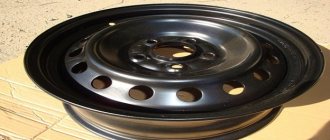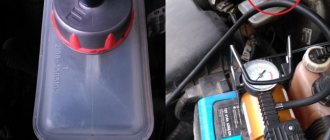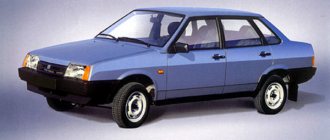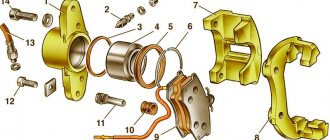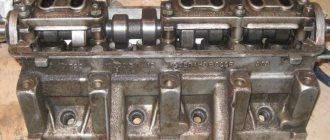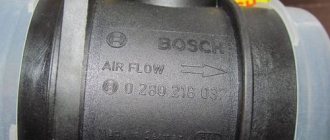Not every driver pays attention to the pressure in the tires of his car. But safety on the road, controllability and maneuvering of the car sometimes depend on the pressure in the tires. In addition, the level of tire pressure affects:
- on fuel consumption,
- uniform wear of the wheel itself,
- may cause hernias on the wheel court.
If the pressure in tires r13 and r14 is increased, then, for example, when hitting an obstacle, the tire may even explode. Incorrect tire pressure r15 will also affect maneuverability when cornering, turning, etc. The following figure will best show the different levels of inflation of car wheels.
Tire pressure
As you can see, just by the wear of the tread you can determine what the problem is with inflating the rim, but it is better not to let it get to that point, but to maintain a certain atmosphere at the required values.
Tire pressure must be checked at least once a month. Professional drivers check every 2 weeks and before each long trip. And an external inspection of the wheels should be done daily before starting the car engine. Although if you are the happy owner of low-profile tires, then it is impossible to determine what pressure should be in the tires by eye.
How important is it to maintain normal blood pressure?
Ensuring optimal vehicle stability on the road is the main task of tires. The safety of the driver and passengers depends on the stability of the vehicle on the road surface. At the optimal pressure level at the point of contact of the tire with the road surface, the load is distributed evenly. Hence all the ensuing consequences - adequate consumption, uniform tire wear, good handling.
It is necessary to measure the parameter on cold tires in the garage just before leaving. You can measure tire pressure using a special device - a pressure gauge.
R13 tires are most often installed on the VAZ-2114 car. This is considered a kind of standard. Although, the car can be equipped with wheels with a radius from R13 to R16.
Tips for choosing the right tire pressure
If you are not installing stock tires, but more expensive ones that suit your driving style, then when purchasing, be sure to ask the seller in what pressure range the tires can be used. Most manufacturers indicate on its side all the necessary technical information: diameter, permissible pressure and other tire markings. When using, adhere to the values indicated on them, and not those determined by the car manufacturer.
Not only the comfort of car operation, but also safety depends on the correct selection of tire pressure. For example, if you are waiting for a long trip on a flat road with a high-quality surface, in this case it makes sense to create the maximum allowable pressure in the tires. This will improve the overall dynamics of the car, its handling and reduce fuel consumption. And the situation is completely different if you drive on bad roads, dirt roads or, even worse, on sandy surfaces. In this case, it is better to reduce the pressure to a minimum. This will provide more contact between the tire and the surface and reduce the harshness of the reaction.
Many SUV models and wheeled military vehicles are equipped with a special automatic or manual tire pressure adjustment system. This increases vehicle permeability when moving on soft soils.
When driving within the city, the best option would be to set the average value of the required pressure. This will provide the greatest comfort while traveling.
Check your tire pressure periodically, once a week is enough. This can be done using a manual automotive pressure gauge. Many modern cars carry out measurements using an electronic control unit and a sensor mounted in the spool; all the necessary information is indicated on the on-board computer. When the pressure drops, the corresponding data is displayed on the dashboard.
Tire pressure should only be measured when the tire is cold.
It is important to remember that tire pressure decreases not only from tire depreciation, but also from constant driving on poor road surfaces, potholes and speed bumps. As tires age, air leaks only get worse. However, the choice of pressure in summer and winter is up to you.
What pressure should be in winter tires r13 VAZ-2114
The task of every driver is to maintain an optimal pressure level. There is an opinion among car enthusiasts that the pressure should be different in the cold and warm seasons. There is some truth in this, but the difference should not be significant.
| Wheel size | Recommended standard air pressure in wheels, kgf/cm2 |
| 175/70 R13 | 1,9 |
| 175/65 R13 | 1,9 |
| 175/65 R14 | 2,0 |
| 185/60 R14 | 2,0 |
Tire pressure rises quickly in summer, so it is best to deflate excess air when the air temperature exceeds 25 degrees Celsius.
In winter, this figure drops faster. Such indicators are typical for a passenger car with an empty luggage compartment. In any case, the recommended value is indicated in the vehicle’s operating book. It is necessary to adhere to the standard certified by the manufacturer at any time of the year. In general, we can say that in winter the wheels should be inflated 0.2 atmospheres more than in summer.
Features of tire inflation in winter and summer
As mentioned above, you need to check the density of tires on a cold car. It is also better to inflate tires, especially in winter, not immediately after using the car, but when the wheels “cool down” a little. This rule applies to both winter and summer maintenance. In winter, we measure the pressure and pump up the tires no earlier than 2 hours after stopping. In summer, due to the high ambient temperature, cooling occurs much more slowly, this should also be taken into account. In winter, the ideal option would be to inflate tires in a warm box or tire shop; this will help to avoid differences in pressure, and in this case the indicators will be close to ideal.
Please note that if the car is fully loaded, the pressure in the tires will increase significantly, this should also be taken into account. Significant changes will also occur when the ambient temperature fluctuates greatly. Therefore, when the weather changes, you need to measure the tire pressure more often.
What are the dangers of deviation from the norm?
In summer, due to high temperatures, the contact area between rubber and the road surface is significantly reduced. The pressure rises, and this is already an alarm bell for the driver. After all, rubber loses its elasticity and does not resist impact loads.
Plus, if you overdo it and overinflate the wheels, you can experience the following troubles while driving a car:
- Wear on the car's chassis increases, the ride becomes uncomfortable, and all the imperfections in the road surface are felt.
- The contact area of the tires with the road is reduced - the braking distance increases.
- During high-speed driving, rubber may rupture, which in itself is not safe.
If, on the contrary, the tires are poorly inflated, the following consequences will emerge:
see also
- Vehicle controllability will deteriorate significantly.
- The amount of fuel consumed will increase.
- On snowy or wet asphalt, the car will have a tendency to skid.
- The vehicle's power will noticeably decrease.
Experienced motorists can visually determine whether tire pressure is normal or not. Beginner car enthusiasts are recommended to take measurements at least once a week. It is enough to arm yourself with a pressure gauge, reset its readings to zero, connect the fitting of the device to the nipple and start applying pressure. Then record the readings of the instrument needle.
Seasonal change in tire pressure
As the ambient temperature changes, the pressure in car tires also changes, due to the heating or cooling of the air inside the wheels.
Tire pressure in summer
First of all, you need to take into account that regardless of the time of year, the pressure in the VAZ 2107 tires should remain the same. In summer, it is recommended to check the pressure more often than in winter, especially when driving along the highway at high speed (every 300–400 km). The fact is that in hot weather the tires become very hot under the influence of the sun, maneuvers, and high-speed driving. All these factors lead to an increase in pressure inside the wheels. If this parameter significantly exceeds the norm, the tire may explode. To check the pressure correctly in the summer, you need to wait until the rubber has completely cooled, and it cools down slowly. On long trips, as a rule, you have to lower the wheels rather than pump them up.
Tire pressure in winter
With the arrival of cold weather, the pressure in car tires decreases noticeably. If at a temperature of +20˚С this figure was 2 bar, then at 0˚С the pressure will drop to 1.8 bar. It must be taken into account that this parameter should be checked and brought to normal in the conditions in which the car is operated. If in winter the car is stored in a warm garage or box, then the pressure must be increased by an average of 0.2 bar in order to compensate for the temperature difference.
Since softer tires (winter) are installed on the car in winter, it is necessary to prevent a decrease in pressure, because a low value of the parameter will lead to rapid wear and failure of the tires. In addition, the likelihood that the wheels may burst on the road increases. There is an opinion among car enthusiasts that on slippery roads it is necessary to reduce the tire pressure to increase the traction properties of the wheels. However, if you look at it, this judgment is fundamentally wrong. This is explained by the fact that as pressure decreases, the area of the contact patch with the road surface increases, as a result of which the grip characteristics of tires on slippery roads deteriorate.
It is also not recommended to underestimate the pressure in winter for the reason that when hitting any unevenness, the chances of damaging the wheel rims increase, since the tires will not be able to provide sufficient rigidity due to the loss of their shock-absorbing properties.
Video: how to check tire pressure
What are the benefits of pumping nitrogen into tires?
Nitrogen in the tires of the VAZ 2114, like any other car, according to tire fitters offering this service, has many useful properties. They claim that this gas:
- Makes blood pressure stable and constant;
- Increases rubber service life;
- Reduces the risk of tire rupture;
- Reduces the likelihood of disc corrosion.
But in fact, all these advantages are ordinary advertising. Injecting nitrogen costs a lot of money. Therefore, it is often recommended in tire shops. But in reality, it doesn’t matter what you pump into the wheels – nitrogen or air. And there is no need to overpay for more expensive gas.
Table: VAZ 2107 tire pressure depending on size and time of year
| Wheel size | Tire pressure in summer (kgf/cm²) | Tire pressure in winter (kgf/cm²) | ||
| Front axle | Rear axle | Front axle | Rear axle | |
| 165/80R13 | 1,6 | 1,9 | 1,7 | 2,1 |
| 175/70R13 | 1,7 | 2,0 | 1,7 | 2,2 |
The table shows data for a car that is stored in a warm garage. Therefore, there is a difference between summer and winter pressure readings of 0.1–0.2 atmospheres, which makes it possible to compensate for the difference in indoor and outdoor temperatures.
The pressure in car tires depends both on the car itself and on the type of tires. This parameter is set from the factory and these values should be adhered to. In this way, you will be able to avoid possible troubles and protect yourself and other road users.
The vehicle tire pressure must be checked regularly and maintained at the values recommended by the vehicle manufacturer. Deviation from the established norm can lead to a variety of consequences, and most importantly, traffic safety depends on it. What pressure should be in the tires and what it affects, we’ll look at it in a little more detail in this article.
Measuring tire pressure with a pressure gauge
When you need to lower your tires a little
In some cases, there are recommendations to slightly lower the tire pressure than specified in the recommendations. There are two such cases:
- In winter, if the pressure is a little less, then better traction occurs. But as the temperature changes, the internal volume in the tire also changes.
- The most popular use for slightly lowered wheels is off-road driving. In this case, the wheels will act on the principle of tracks. Which will increase cross-country ability.
But it is difficult for an inexperienced driver to determine by what indicators to reduce the pressure. Therefore, we do not recommend experimenting.
Conclusion: the pressure in car tires must be checked regularly, maintained at the level recommended by the manufacturer, and weather and road conditions taken into account. This will extend their life and help make your ride safer.
WHAT IS THE RISK OF DEVIATION FROM THE SET PARAMETERS
Front-wheel drive cars of the Volzhsky Automobile Plant, such as the VAZ 2110, VAZ 2114 and VAZ 2115, can be equipped with wheels with a radius of R13, R14, R15 and R16, but the standard cars are equipped only with rims and tires of the 13th and 14th radius. The optimal tire pressure depends primarily on the load and weight of the vehicle; much also depends on road conditions and ambient temperature.
If the wheels are poorly inflated, then:
- The tire tread will wear out faster;
- It will become more difficult to control the car and turn the steering wheel harder;
- Fuel consumption will increase, and the more flat the tires, the more noticeable the gasoline consumption;
- The car will become prone to skidding, especially on wet and snowy roads, and stability will be lost;
- The power of the car will decrease as the resistance to movement will increase.
How to properly inflate tires in winter
A few tips on how to properly inflate your tires in winter :
- If you are going to inflate cold tires, it is better to do it outdoors. Because the temperature of the air inside the tire will be equal to the ambient temperature. You should rely on the manufacturer's recommendations. The optimal pressure in car tires in winter and summer is no different.
- If you pump up your tires in a warm garage, where the temperature inside is higher than outside. We recommend increasing the optimal values to 0.2 bar. In this way you will compensate for the temperature difference.
The driving performance of a car is affected not only by the degree of inflation of the wheels of a passenger car, but also by the tire itself. Choose quality winter tires .
A slight decrease in tire pressure is also allowed, i.e. to a level less than optimal. When is it necessary and what does it give:
- Relevant when you need to move on slippery road . Reducing tire pressure by 0.1-0.3 bar will increase the contact patch with the road, providing more stable traction.
- When driving off-road . The car will be more passable.
INFLUENCE OF WEATHER CONDITIONS AND ROAD FACTORS
The pressure in VAZ tires in summer should, in principle, be the same as in winter. But in practice in winter it is made a little lower for a number of reasons:
- Slightly lower tires allow you to better control the car on slippery roads, it becomes more stable;
- The suspension is made softer, and road unevenness is less felt;
- The braking distance becomes shorter, reducing the likelihood of an emergency.
It is necessary to take into account the fact that after a temperature change (after leaving a warm garage on a frosty street), the pressure in the R14 tires will become less due to physical factors. Therefore, you should check it before you hit the road and, if necessary, pump up the tires. Also, when it gets warmer after winter, pressure measurements should be taken.
The pressure in R13 tires in summer is usually maintained at 1.9 atm, but this level is designed for an average vehicle load (two or three people in the cabin). If the car is fully loaded, then the pressure should be increased on the front axle to 2.0-2.1 atm., on the rear axle to 2.3-2.4 atm. The spare wheel is inflated to 2.3 atm.
Russian roads are not of good quality, and therefore many car owners deliberately lower the tire pressure somewhat so that all the unevenness of the road surface is not so noticeably felt when driving. Typically, in summer the wheels are lowered by 5-10%, and in winter by 10-15% of the norm. On flat roads you can stick to the factory standard.
For example, a table of car tire pressures:
For example, a table of car tire pressures
Why is it important to know what pressure should be in the tires of a car?
First of all, you need to understand that modern car tires are tubeless, i.e. the entire space from the disc to the tire is filled with air without special rubber tubes, as was the case before. These tires have a high level of pressure sensitivity. If the pressure in them decreases by about a fifth of the norm or, on the contrary, increases by more than 20-25%, then the tires wear out faster and driving on them becomes unsafe.
Consequences of incorrect tire pressure
In addition, as a result of low or high tire pressure, fuel consumption increases, the vehicle loses stability, and cross-country ability decreases. In the most extreme cases, an incorrectly inflated tire can “shoot” (burst/explode). It’s good if this happens when the car is stationary, but if it happens while driving, it may well cause a serious accident.
Please note that even in perfectly inflated tires, the pressure may deviate from the norm due to weather conditions (changes in temperature), uneven road surfaces, potholes, etc.
LARGER DIAMETER WHEELS
From the factory, the installation of wheels with diameters R15 and R16 is not provided, but some car enthusiasts, in pursuit of fashion and improved technical characteristics, install them on their VAZs. And accordingly, you need to know what the pressure should be in the R15 tires, and what the pressure should be in the R16 tires. It all depends on the workload of the VAZ model. With an average vehicle load, the wheels are inflated to 2 kgf/cm²; on a loaded car, it is better to inflate them to 2.2 kgf/cm². And if there is a lot of heavy luggage in the trunk, then the rear tires are pumped up by another 0.2 kgf/cm². It turns out that the pressure in R14 tires is approximately the same as the pressure in R15 and R16 tires (for VAZ 2110-2115 models).
What does the normal indicator depend on?
The main difficulty in monitoring tire pressure is due to the fact that there is no single standard for all wheels and cars. This variable is affected by several conditions.
Type and model of the car. If we remember that tires must provide sufficient resistance to the weight of the car, it becomes clear that the pressure in the wheels of a small car and a crossover cannot be the same, even if it is possible to install wheels of the same diameter on them - these cars have different weights. Therefore, you should not take the recommendations on the tires themselves as a starting point.
And due to differences in production standards between automakers and body sizes of the same class, it is important to know the recommendations for a specific model. Typically this information is placed in the driver's door opening or on the inside of the gas tank cap.
Wheel diameter
. In those cheat sheets mentioned above, there will most likely be several values - one for each recommended wheel size with a different disc radius. It's all about the size of the cylinder.
Example of a sticker with manufacturer's recommendations
Season
. Due to the fact that heated air increases in volume and cold air contracts, the pressure inside the tire also changes. Therefore, in winter, the wheels will have to be inflated by 0.2-0.3 atmospheres more - you can more accurately navigate by the temperature difference: for every 10 degrees there is approximately 0.1 bar.
Road surface
. It is almost impossible to guess which specific road you will have to take today. But you can focus on the purposes for which the car was purchased: a frame SUV for fishing is unlikely to often drive on flat surfaces, and a comfortable sedan will not have to constantly overcome potholes and bumps. In the first case, it is recommended to increase the contact surface of the tires, lowering them by 0.1-0.3 bar, and in the second, focus on standard values. And if you have a long trip on the highway, you should increase the pressure by 0.2-0.3 atmospheres.
Driving style
. Overinflated tires combined with aggressive behavior on the road are a dangerous cocktail: a small contact patch with the road surface will not allow you to brake in time, and the rubber may burst from a sharp impact in a small hole or on a bump. Therefore, impatient drivers should stick to standard values or even lower the wheels slightly for their own safety. And for calm motorists, it is enough to adjust the average pressure readings depending on the season and type of roads.
METHODS OF MEASUREMENT
How to measure the tire pressure of VAZ cars? The measurement can be made using a special dial pressure gauge, but it should be noted that they may have an error of 0.2 atm. The pressure gauge can be either a separate device or as part of a wheel inflation pump.
We measure the pressure very simply:
- Reset the pressure gauge readings to zero;
- Remove the cap from the wheel spool (if there is one);
- Place the pressure gauge fitting on the nipple and press;
- We look at the arrow reading on the device.
It is recommended to take measurements at least once a month if the machine is used regularly. It is recommended to check tire inflation before leaving the garage after a long stay.
Pressure may increase when tires heat up. This often happens if the driver prefers a dynamic driving style with frequent and sharp braking. Therefore, measurements are taken on the car before the trip, when the wheels have not yet warmed up.
How to measure blood pressure
In cars such as the VAZ 2107 or VAZ 2114, of course, there are no automatic monitoring systems already installed at the factory. Therefore, the driver must take care of himself.
Gas pressure gauge for measuring tire pressure
There are several types of devices that allow you to monitor tire pressure. They have different capabilities, which accordingly affects the cost and ease of use.
- For those who infinitely value their lives and safety for them - this is not just a word, there are special tire pressure monitoring systems. Their installation is not easy and the cost is high, but there are a lot of positive qualities. They allow you not only to perfectly inflate your tires, but also to monitor any changes in pressure, which makes it possible to promptly eliminate all shortcomings and problems.
- Various types of pressure gauges: mechanical, electronic, should always be in the arsenal of any driver. Each type has its pros and cons, as well as a significant difference in cost.
- The most primitive devices are cap devices. They don't show exact numbers, but their color scale will indicate whether the tire pressure is normal or not.
Each driver in his lifetime manages to try all types of devices and chooses the most convenient model. Do not forget about the accuracy of the device, not all of them differ in it, as well as the specifics of use.
For a long time to come, VAZs will drive along our roads, deftly maneuvering between proud foreign cars. Indeed, despite the lack of advanced options in most models, they have proven themselves well. And, if their drivers also pay close attention to the pressure in the tires of VAZ cars, then driving safety will be higher.


